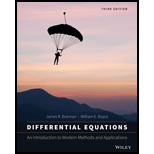
Concept explainers
After viewing the results of her computer experiments, it slowly dawns on the hydrologist that the “optimal shape” of the container is consistent with what would be expected based on the conceptualization that the water in the ideal container would consist of a collection of small parcels of water of mass
Want to see the full answer?
Check out a sample textbook solution
Chapter 8 Solutions
Differential Equations: An Introduction to Modern Methods and Applications
Additional Math Textbook Solutions
A Survey of Mathematics with Applications (10th Edition) - Standalone book
Using and Understanding Mathematics: A Quantitative Reasoning Approach (6th Edition)
Calculus for Business, Economics, Life Sciences, and Social Sciences (14th Edition)
Calculus Volume 2
Introductory Combinatorics
Introductory Mathematics for Engineering Applications
- What is a carrying capacity? What kind of model has a carrying capacity built into its formula? Why does this make sense?arrow_forwardWhat is the significance of R and R2 in gression model?arrow_forward: 39% in 30m 20 CALENDAR Travel to Home Today at 11:02 PM Green Street f... Lumen... Sign In or School.. ohm Rukayat Balogun오 | User Settings My Classes Log Out ork manager ges Forums Calendar Gradebook 1:30am Fall 2018> Assessment pplications of Systems of Equations Due in 11 hours, 28 minutes. Due Fri 12/21/2018 10:00 am Monico needs to mix a 10% alcohol solution with a 50% alcohol solution to create 100 milli!eters of a 26% solution. How many millileters of each solution must Monico use? Answer: Monico must mix -milli!eters of 10% solution and milli!eters of 50% solution. Points possible: 1 Unlimited attempts License Submit onarrow_forward
- Conceptual Questions: 1. Suture anchors are used to reattach tendons or ligaments to bone. You are creating an anchor system for the ACL that involves two suture anchors on the distal end of the joint. You plan a study that compares this new anchor system to the currently used anchor system. Based on your experimental study, you have two outcome measures: i) the failure status of the suture during an experimental protocol and ii) the ultimate tensile failure load. Complete the following tasks: A) Would the two experimental groups in Figure lii be considered independent or disjoint? Is the outcome measure in Figure 1i considered independent or disjoint? Provide a brief explanation for each Figure li: Number of Occurrences 10 Figure lii: 40 Failure Load (kN) 30 20 10 5 0 Current anchors Failure ■ No failure Current anchors Experimental anchors Experimental anchorsarrow_forwardAccumulation of mercury (Hg) in fish is hypothesized to correlate with the fish size. Barbonymus schwanenfeldii is a species commonly found in a dam in Sarawak. Table 1 shows data of Hg concentration (mg/kg) present in three sizes of fish caught in the dam in triplicates. (i, ii, iii was already answered.)arrow_forwardI need 17.10 please Exampme: 17.6 An attractive body. The researchers recruited a sample of 40 female and 40 male heterosexual Caucasian college students from British universities for a study on the attractiveness of body types. Among adults, a body mass index (BMI, in kg/m²) value between 18.5 and 24.9 is considered healthy, but attractiveness may not be solely due to health. Using a 3D computer avatar, the participants constructed what they considered to be the ideal body of an adult of their own gender. Here is the Minitab result for the mean ideal BMI for women (top) and men (bottom):5 One-sample T N=40 Mean=18.850 Stdev= 1.750 SE mean= 0.277 95% CI (18.290, 19.410) One-sample t N=40 Mean= 25.860 Stdev= 3.950 SE mean= 0.625 95% CI (24.597, 27.123) A) Interpret the confidence interval for women in context. How does it relate to the definition of a healthy BMI? (b) Interpret the confidence interval for men in context. How does it relate to the definition of a healthy…arrow_forward
 Linear Algebra: A Modern IntroductionAlgebraISBN:9781285463247Author:David PoolePublisher:Cengage Learning
Linear Algebra: A Modern IntroductionAlgebraISBN:9781285463247Author:David PoolePublisher:Cengage Learning

